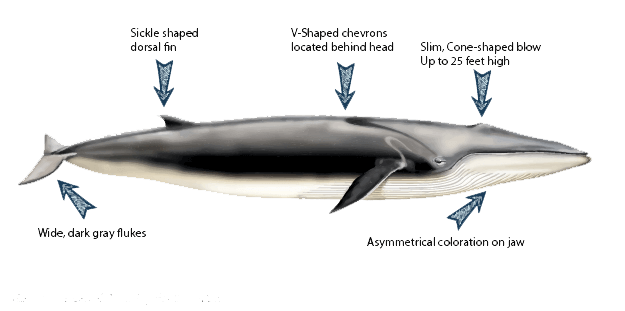The fastest one of all whales – The Fin Whale
Fin whales , commonly known as Finback Whales or Razorback whales are the second largest living mammal on the Earth and the second biggest rorqual whale falling just behind the majestic Blue whale. Like all rorqual whales they are an extremely cosmopolitan specie, found in all the major Oceans from polar to tropical waters. The outstanding Sea of Cortes is considered an all year round residency for some of the North Pacific population.
If you’re eager to witness whales in their natural habitat, join us and explore our captivating whale watching tours in San Jose del Cabo • Los Cabos • Mexico • B.C.S.
Appearance
The Fin Whale is distinguished by their great size, streamlined bodies, pointed snout, flatter V shaped heads and unique dorsal fin. Their sleek bodies are a brownish dark grey above and white or cream color below like many other species . The pectoral fins are relatively short with pointed tips and the rear fluke slightly triangular with the same shadings.
Fins whales have a unique colorization feature among all other cetaceans – their faces are asymmetrical. The right side of their jaw , right lip and the right side of their baleens are a yellowish-white, while the left side is grey. Fin whales have been nick named the Razor back because of a distinct ridge behind their dorsal fin, the dorsal fin is located 2/3 down the back, it has a pointed tip and generally slopes backwards giving the fin a very distinguished look like no other dorsal fin. Fin whales can measure up to 85ft and weight between 40 to 80 tons.
Fin whales can easily be confused with Sei whales or Brydes’s whales. Hybrid species created by interbreeding of blue whales & fin whales can occasionally been seen in the wild making their recognition a little more complicated than other species.
- Ballena de Aleta
- Rorcual comun
- Male: 25m
- Female: 27m
- Calf: 6.5m
- Male: 70,000 kg
- Female: 120,000 kg
- Calf: 2,700 kg
- Small invertebrates (euphausiids and copepods)
- Fish (including herring, mackerel, and sand lance)
- Squid
Distribution
You can find these whales in all the oceans around the world. They do tend to favor the tropics but you can find them in the Polar Regions as well. The majority of them though seem to spend most of their time in the cooler waters. It is believed this is due to the food sources being more plentiful there.

Populations & Migrations
Two sub species exist of fin whales: Northern (inhabits oceans of the northern hemisphere : physalus physalus) and southern (inhabits oceans of the Southern Hemisphere : physalis quayi). Generally the north species are smaller in size than the south species.
Their world population is estimated to be between 80 000 and 100 000 individuals. Like many other whales fin whales were severely hunted in the 70’s. Fin whales are today still considered an endangered specie.
No specific migration pattern has been observed for these whales, but Iike all misticetes, Fin whales can migrate to subtropical waters for matting and calving during the winter months and to colder areas of the Arctic and Antartic for feeding during the summer months. Though recent evidence suggests that fin whales may disperse into deep ocean waters during winter rather than migrating between winter and summer regions, explaining the possibility of the presence of resident groups of fin whales in some areas, such as in the Sea of Cortes.
Fin whales have long life expectancies that can reach 90 years of age.
Behaviors
Fin whales also renowned as being the greyhounds of the Ocean, they are fast swimmers with an average cruising speed of 18mph but theses olympic swimmer can reach bursts of out to 32mph. Fins have the capacity of breaching, typically landing on their belly provoking tremendous splashes. They do not seem bothered with boats and can easily outrun vessels and dive deep to get away from boats when felt threathened.
Fin whales generally swim in small groups up to 6 individuals but can be spotted in more individuals while eating or mating.
Fin whales being the second biggest baleen whale count up to 100 grooves under their throats adding to their streamline shape, all of which can expand while when they lung feed of small fish or krill.
One of the reasons we know little about fins is because they can be pelagic whales meaning they spend most of their time out in the deep seas away from the coasts. Similar to they big cousin the blue whale they remain a secretive specie when it comes to their mating rituals.
Their communication is also very similar to the blue whales, fin whales emit low frequency noises (infrasound) which can be as loud as 188 decibels, they cannot be heard by humans but can travel to the whales up to 850km away.
Reproduction
Reproduction takes place during the winter. It takes about 11 months from conception for the new baby to arrive. Calves measure about 21 feet in length. They are believed to weigh about 4,000 pounds at birth. Almost all whales only have one baby at a time with an occasional set of twins. It has been documented that the Fin Whale sometimes has up to six babies at a time.




